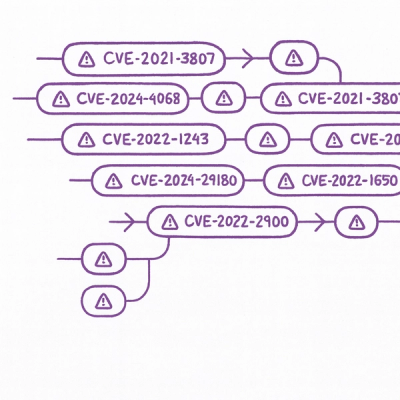
Security News
Astral Launches pyx: A Python-Native Package Registry
Astral unveils pyx, a Python-native package registry in beta, designed to speed installs, enhance security, and integrate deeply with uv.
= DS - Data Structures for Ruby
{}[https://travis-ci.org/knife/ds]
DS provides some popular data structures not implemented in Ruby natively.
Data structures included in this gem:
== Instalation
gem install ds
== Usage
require 'ds' stack = DS::Stack.new
To not have to type "DS::" before each class, use:
include DS stack = Stack.new
=== Pair
Pair is simple key-value data structure.
Creating new Pair p = Pair.new(3, 9)
Accessors defined on Pair object:
p.key #=> 3 p.value #=> 9 p.value = 27
p.first #=> 3 p.second #=> 9 p.second = 27
=== Stack
Stack is very simple data structure which allows access only to the top element. More: {Stack}[http://en.wikipedia.org/wiki/Stack_(abstract_data_type)]
Creating new Stack (implemented as Array). stack = Stack.new with initial values: s = Stack.new(:first, :second)
Creating new Stack (implemented as List). stack = Stack.create
The following methods are available on a Stack:
Examples: stack.empty? #=> true stack.push :first stack.push :second stack.size #=> 2 stack.peek #=> :second stack.empty? #=> false stack.pop #=> :second stack.size #=> 1
=== Queues
Queue is First-In-First-Out (FIFO) data structure. Which means that first element added to the queue will be the first one to be removed. More: {Queue}[http://en.wikipedia.org/wiki/Queue_(data_structure)]
==== SimpleQueue
Creating new SimpleQueue (implemented as Array). q = SimpleQueue.new with initial values: q = SimpleQueue.new(1, 2, 3)
Creating new SimpleQueue (implemented as List) q1 = SimpleQueue.create
The following methods are available on a Queue:
Examples: q.enqueue :first q.push :second q.peek #=> :first q.length #=> 2 q.empty? #=> false q.dequeue #=> :first q.shift #=> :second q.empty? #=> true
==== Priority Queue
In opposite to simple Queue, in PriorityQueue each element is associated with a "priority". More: {Priority Queue}[http://en.wikipedia.org/wiki/Priority_queue]
Creating new Priority Queue (implemented as BinaryHeap)
q = PriorityQueue.new
By default higher value means higher priority but you can define own priority order by passing block to constructor:
PriorityQueue.new { |a, b| a < b }
To add new element to priority queue use #unshift or #push method: q.push(value, priority)
To remove element from priority queue use #shift or #pop method. The interface is very similar to SimpleQueue.
Examples: q.push(:important, 3) q.push(:very_important, 5) q.push(:nevermind, 1)
q.shift #=> :very_important q.peek #=> :important q.length #=> 2 q.shift #=> :important q.peek #=> :nevermind
==== Indexed Priority Queue
Indexed Priority Queue is special form of PriorityQueue with constant access to any element. Additionaly you can easily change priority of any element stored on queue.
Creating new Indexed Priority Queue q = IndexedPriorityQueue.new or IndexedPriorityQueue.new { |a, b| a.key < b.key }
IndexedPriorityQueue inherits from PriorityQueue so all methods from PriorityQueue are available.
Examples: q.push(:important, 3) q.push(:very_important, 5) q.push(:nevermind, 1)
q.peek #=> :very_important
q.change(:nevermind, 10) q.peek #=> :nevermind
Elements stored on priority queue are wrapped in Pair object, when you call get method this object is returned: q.get(:very_important) #=> Pair.new(5, :very_important) q.include?(:very_important) #=> true
=== Lists
=== List
List is an ordered collection of values. Each element of list has pointer to the next element (last element points to nil). This implementation uses doubly linked list underhood. More: {List}[http://en.wikipedia.org/wiki/List_(data_structure)]
Creating new List l = List.new l.append(2) or list = List.new(1, 2, 3, 4)
Examples:
Simple operations on lists list.length #=> 4 list.append(5).to_a #=> [1, 2, 3, 4, 5] list.unshift(0).to_a #=> [0, 1, 2, 3, 4, 5] list.remove(list.head).to_a #=> [1, 2, 3, 4, 5] list.shift #=> 1
Accessing first and last element list.head.data #=> 2 list.tail.data #=> 5
list.first #=> 2 list.last #=> 5
Accessing by index list[2].data #=> 2 list.at(2).data #=> 2 list[-1].data #=> 4 list[1..2].map(&:data) #=> [2, 3] list[1,3].map(&:data) #=> [2, 3, 4]
Modifying elements on given index: list[2].data = 8 list[2].data #=> 8 list[2] = [9, 10] #=> [1, 2, 9, 10, 4] list[0,1] = 0 #=> [0, 2, 3, 4] list[2..3] = ['x', 'x'] #=> [1, 2, 'x', 'x']
Checking if given element exists on list list.get(el) #=> el or nil list.get!(el) #=> raises Exception if not found
Reversing list.reverse!.to_a #=> [5, 4, 3, 1, 0]
Enumerable methods are also available
list.map{ |e| e.data } #=> [1, 2, 3, 4] list.inject(0){ |a, e| a + e.data } #=> 10
Append one list to other list list1.concat(list2)
Comparable module is included so you can:
Check if lists are equal list1 == list2
Check if one list is greater than other (same rules as in Array class) list1 > list2
Other operations
=== Trees
==== Tree
A tree is a data structure with nodes organised in hierarchy. More: {Tree}[http://en.wikipedia.org/wiki/Tree_(data_structure)]
Building Tree
t = Tree.new(2) c1 = t << 5 c2 = t << 8 t << 9
c1 << 4 c1 << 10 c3 = c2 << 3
Methods: t.leaf? #=> false c3.leaf? #=> true
c1.sibblings.map &:data #=> [8, 9] c1.parent.data #=> 2
t.height #=> 3 t.width #=> 3 t.leaf_count #=> 4
t.levels #=> {1=>1, 2=>3, 3=>3}
Other methods
Enumerable Module is also included. t.map { |node| node.data } #=> [2, 5, 8, 9, 4, 10, 3]
==== Binary Tree
BinaryTree is sublass of Tree. In BinaryTree each node can have at most two children. More: {BinaryTree}[http://en.wikipedia.org/wiki/Binary_tree]
Building tree bin_tree = BinaryTree.new [2, 5, 8, 9, 11, 12, 14].each { |x| bin_tree.insert(x) } #builds complete binary Tree
Accessors defined on BinaryTree object: bin_tree.left.data #=> 5 bin_tree.right.data #=> 8
==== Red Black Tree
Red-black tree is symbol table data structure. It's very simmilar to hash, but internally uses tree (perfect balanced binary tree) and not depends on hash function. Red black trees aren't as fast as hashes but supports ordered operations.
rb = RedBlackTree.new
rb.insert(:z, 3)
rb.insert(:p, 2)
rb.insert(:a, 1)
rb.get(:a) #=> 1
You can also create RBT by passing hash to constructor rb = RedBlackTree.new(a: 1, p: 2, z: 3)
Hash like accessors are defined
rb[:z] = 3 rb[:z] #=> 3
You can convert RedBlackTree to Hash with to_h method: rb.to_h #=> {a: 1, p: 2, z: 3}
Enumerable is included and traversing is ordered by key rb.map(&:key) #=> [:a, :p, :z]
==== Binary Heap
BinaryHeap is tree in which every node satisfies heap property. Binary Heap allows very fast access to maximum or minimum element of the tree (const access). More: {Binary Heap}[http://en.wikipedia.org/wiki/Binary_heap]
Creating
Maximum Binary Heap max_heap = BinaryHeap.new(9, 8, 4, 5, 11, 6) or max_heap = BinaryHeap.max(9, 8, 4, 5, 11, 6)
Minimum Binary Heap min_heap = BinaryHeap.min(9, 8, 4, 5, 11, 6) or BinaryHeap.new(9, 8, 4, 5, 11, 6){ |parent, child| parent < child }
You can set heap relation by passing block to BinaryHeap constructor.
Examples max_heap.shift #returns max element (11) max_heap.to_a #=> [9, 8, 6, 5, 4] max_heap.insert 15 max_heap.shift #=> 15
min_heap.shift #returns min element (4)
==== Trie
Trie is an ordered tree data structure which allows very quick search: O(k), where k is word length. More: {Trie}[http://en.wikipedia.org/wiki/Trie]
Creating trie = Trie.new
Setting custom alphabet (memory usage depends on alphabet size) trie.alphabet = %w(a b c d)
Examples trie.insert('thing', true); trie.find('thing') # => true trie.delete('thing') or trie['one'] = 'thing' trie['one'] # => 'thing'
Enumerable module is included so you can iterate through trie: trie.map { |k, v| [k, v] } # => [['he', true], ['hello', true], ['help', true]]
Finding all words matching given prefix: trie.with_prefix('th') # => ['the', 'thing'] trie.with_prefix('yeti') # => []
Alternatively you can pass block to this method: trie.with_prefix('th'){ |word, val| res[word] = val } # => {'the' => true, 'thing' => true}
==== Tree Traversals
b = BinaryTree.new [2, 5, 8, 9, 11, 12, 14].each{ |x| b.insert(x) }
walker = TreeWalker.new(b)
Iterating in postorder walker.traverse(:postorder) #=> [9, 11, 5, 12, 14, 8, 2] Iterating in inorder walker.traverse(:inorder) #=> [9, 5, 11, 2, 12, 8, 14] Iterating in preorder walker.traverse(:preorder) #=> [2, 5, 9, 11, 8, 12, 14]
Iterating in BFS order walker.each{ |x| x } #=> [2, 5, 8, 9, 11, 12, 14]
You can also pass block to traverse method walker.traverse(:inorder){ |n| n.data**2 }
If you want to change value of tree nodes, use recalculate! method walker.recalculate!(b, :preorder, 0) { |e, a| a + e.data }
=== Arrays
==== Array2D
Simple two dimensional array(matrix). Array2D extends automatically like simple Array.
Creating discrete_matrix = Array2D.new(2, 0)
First argument is size of row(or column) and second is default value of matrix.
Examples discrete_matrix.to_a #=> [[0, 0], [0, 0]] discrete_matrix[3, 3] #=> 0
==== ExpandableArray
Automaticaly fills empty slots with custom value:
arr = ExpandableArray.new(0, 0) arr[4] = 1 #=> [0, 0, 0, 0, 4]
==== TriMatrix Triangular matrix is a special kind of matrix where M[x,y] = M[y,x]. More: {Triangular Matrix}[http://en.wikipedia.org/wiki/Triangular_matrix]
Creating tri_matrix = TriMatrix.new tri_matrix[0, 1] = true tri_matrix[0, 2] = true
Examples tri_matrix[0, 1] == tri_matrix[1, 0] #=> true
=== Sets
==== IndexedSet IndexedSet is a set whose elements are indexed. In opposite to Array, duplicates are not allowed. Internally uses hash for fast access and array for ordering.
Creating new Indexed Set set = IndexedSet.new
Examples set.push(:first) #=> 0 set.push(:second) #=> 1 set.index(:first) #=> 0 set.to_a #=> [:first, :second]
FAQs
Unknown package
We found that ds demonstrated a not healthy version release cadence and project activity because the last version was released a year ago. It has 1 open source maintainer collaborating on the project.
Did you know?

Socket for GitHub automatically highlights issues in each pull request and monitors the health of all your open source dependencies. Discover the contents of your packages and block harmful activity before you install or update your dependencies.

Security News
Astral unveils pyx, a Python-native package registry in beta, designed to speed installs, enhance security, and integrate deeply with uv.

Security News
The Latio podcast explores how static and runtime reachability help teams prioritize exploitable vulnerabilities and streamline AppSec workflows.

Security News
The latest Opengrep releases add Apex scanning, precision rule tuning, and performance gains for open source static code analysis.